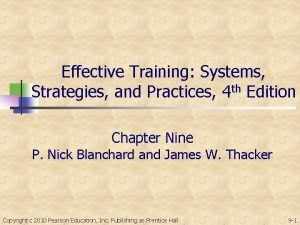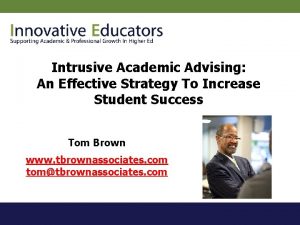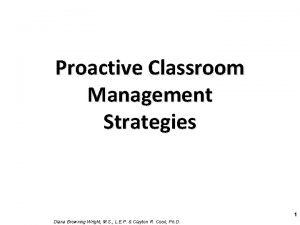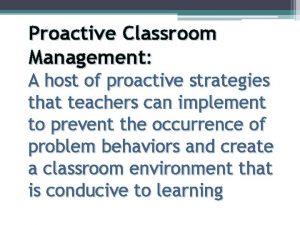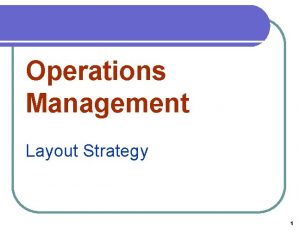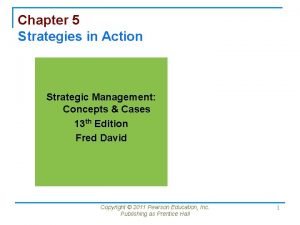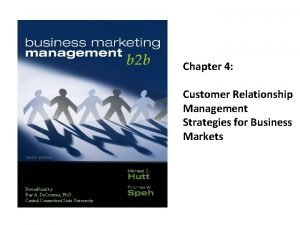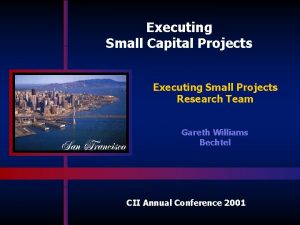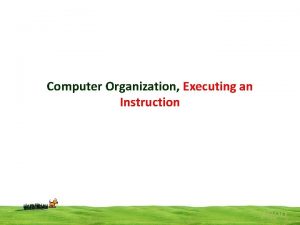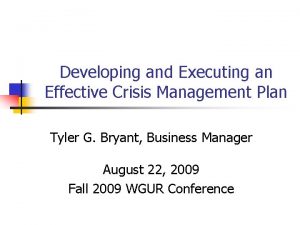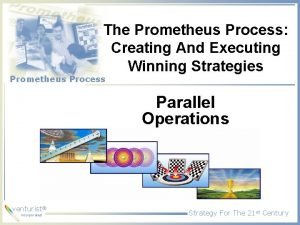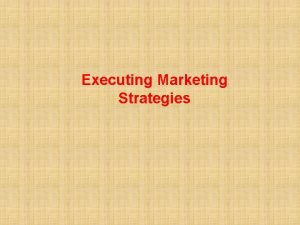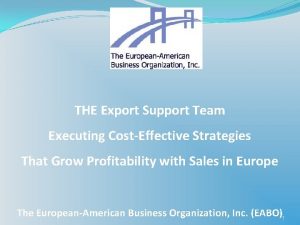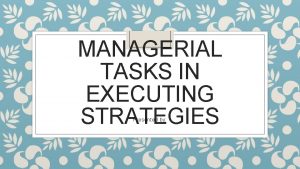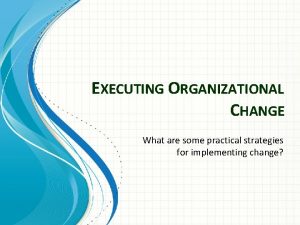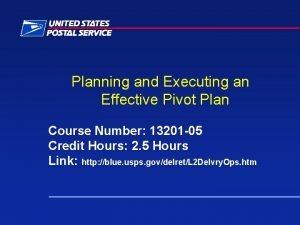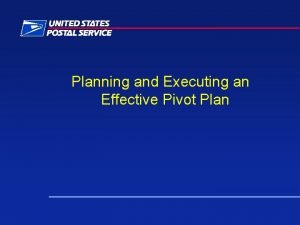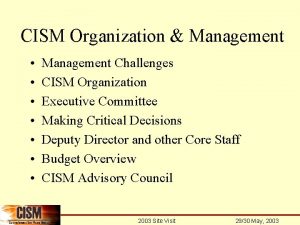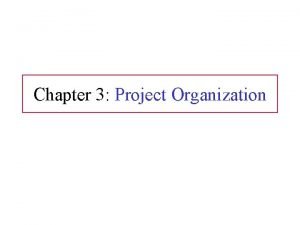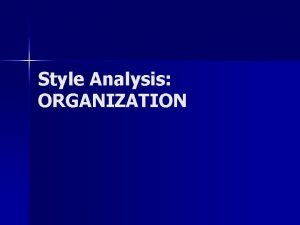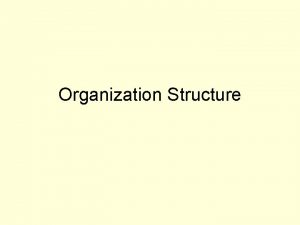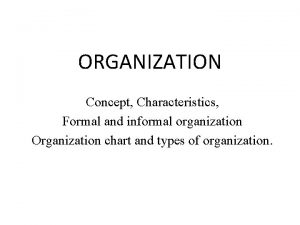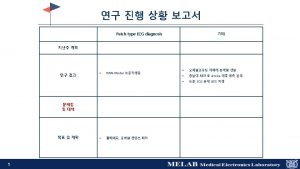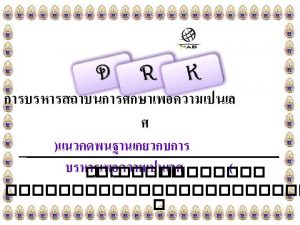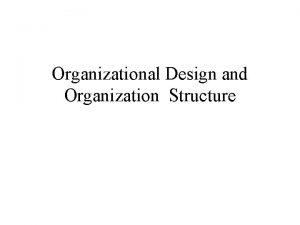FROM EFFECTIVE ORGANIZATION TO EFFECTIVE MANAGEMENT Executing strategies





















- Slides: 21

FROM EFFECTIVE ORGANIZATION TO EFFECTIVE MANAGEMENT Executing strategies and Becoming a successful manager

Being a Manager and the Challenges of Execution Questions: § Why is it hard to motivate employees? § What are some of the strategic tensions in organizations? § What are some of the myths and realities of managing?

Are you a good manager? • How do you manage yourself? • How do you manage your network? • How do you manage your team?

How do you • What really motivates employees? motivate • What are some your possible best employees practices?

As a manager, what is expected of us?

What motivates employees?

Theories of Motivation and Organizational Commitment Expectancy Theory Work effort is directed to behavior that people believe will lead to valued outcomes Elements Effort-Performance-Outcome Value of outcomes Cognitive Theory Work effort will be greater if one believes that the behavior is something they intrinsically value Elements Volitional action Visible action Irreversible action

Application of Expectancy Theory Expectancies Objectives Applications Effort to Performance To increase the belief that employees are capable to carry out the job successfully q. Select people with required skills and knowledge q. Provide required training and clear expectations q. Let employees master the skills needed q. Provide examples of similar employees who successfully master the task q. Provide coaching to employees who lack selfconfidence Performance to Outcomes To increase the belief that good performance will result in valued outcomes q. Measure job performance accurately q. Explain clearly the outcomes that the successful performance will produce q. Describe how the employee’s rewards were based on past performance q. Provide examples of other employees with good performance Value of Outcomes To increase the expected value of outcomes resulting from desired performance q. Distribute rewards that employees value q. Individualize rewards q. Minimize the existence of possible negative outcomes

Tools and organizational actions for effective motivation PRIMARY MECHANISM ORGANIZATIONAL ACTION REWARD SYSTEM q. Sharply differentiate good performers from average and poor performers q. Tie rewards clearly to performance q. Pay as well as your competitors CULTURE q. Foster mutual reliance and friendship among coworkers q. Value collaboration and teamwork q. Encourage sharing of best practices JOB DESIGN q. Design jobs that have distinct and important roles in the organization q. Design jobs that are meaningful and foster a sense of contribution to the organization PERFORMANCEq. Increase the transparency of all processes MANAGEMENT AND q. Emphasize their fairness RESOURCE-ALLOCATION q. Build trust by being just and transparent in granting rewards, assignments, and other forms of recognition

What makes an executive effective? Questions and Actions • Ask, "What needs to be done? "What are my priorities? • Ask, "What is right for the enterprise? " • Develop action plans • Take responsibility for decisions • Take responsibility for communicating • Focus on opportunities rather than problems. • Run productive meetings. • Say "we" rather than "I" and • Listen first and speak last. Peter Drucker

Common managerial tensions and their symptoms Profitability Versus Growth • Swinging between a growth push and a productivity push • Giving priority to reducing costs in difficult times and to boosting growth in boom times • Low or falling share or price relative to competitors • Falling market growth and high unit costs relative to competitors Short Term Versus Long Term • Swinging between a focus on strategy and a focus on execution • Increasing reliance on profitability rather than growth to achieve earnings growth, or vice versa • Difficulty in hitting earnings targets without delaying investments • Low or falling investment compared with competitors and relative to earnings growth • Investment following earnings; investing at same times and on same things as competitors Whole Versus Parts • Swinging between centralization and decentralization • Debates about accountability versus authority versus ownership • Few voluntary interactions among business units or between business units and the corporate center • Strong separate cultural identities across business units or functions • A culture of blame and finger-pointing

Changing roles of executives • Senior executives: § Focus on organizational context rather than strategic content § Protect and reinforce organizational norms and values • Middle level executives § Coaching, supporting, and developing business units § Delegate responsibility • First-line Executives § Developing/motivating teams and building unit’s capabilities § Developing unit level strategies

Myths and realities of being a manager MYTH REALITY Defining characteristic of the new role: Authority "Now I will have the freedom to implement my ideas. " Interdependency "It's humbling that someone who works for me could get me fired. " Source of power: Formal authority "I will finally be on top of the ladder. " "Everything but" "Folks were wary, and you really had to earn it. " Desired outcome: Control "I must get compliance from my subordinates. " Commitment "Compliance does not equal commitment. " Managerial focus: Managing one-on-one "My role is to build relationships with individual subordinates. " Leading the team "I need to create a culture that will allow the group to fulfill its potential. " Key challenge: Keeping the operation in working order "My job is to make sure the operation runs smoothly. " Making changes that will make the team perform better "I am responsible for initiating changes to enhance the group's performance. "

Seven Surprises for New CEOS • Bearing full responsibility for a company's success or failure, but being unable to control most of what will determine it. • Having more authority than anyone else in the organization, but being unable to wield it without unhappy consequences.

• You Can't Run the Company Before becoming CEO, most executives are responsible for a major business or have been COO. They are skilled at running businesses and relish the opportunity to run an entire organization. As new CEOs discover pretty quickly, however, running the business is but a small part of the job. • Giving Orders Is Very Costly The CEO is undoubtedly the most powerful person in any organization. Yet any CEO who tries to use this power to unilaterally issue orders or summarily reject proposals that have come up through the organization will pay a stiff price. Giving orders can trigger resentment and defensiveness in colleagues and subordinates. Second-guessing a senior manager can demoralize and demotivate not only that person but others around him, while eroding his authority and

• It Is Hard to Know What Is Really Going On Even when CEOs understand that they cannot oversee every aspect of their companies, they nevertheless assume-wrongly -that they will be able to learn everything they need to know. Certainly, CEOs are flooded with information, but reliable information is surprisingly scarce. All information coming to the top is filtered, sometimes with good intentions, sometimes with not such good intentions. • You Are Always Sending a Message The typical new CEO knows that his actions will be noticed by those in his company. What he does not generally realize is the extent to which his every move-both inside and outside the organization-will be scrutinized and interpreted. His words and deeds, however small or off-the-cuff, are instantly spread and amplified, and sometimes drastically

• You Are Not the Boss Many new CEOs initially assume that they have finally reached a position where they have ultimate authority. They soon learn that the situation is much more complicated than that. He still reports to the board of directors. The board hired him and can also fire him; it has the power to evaluate his performance, set his compensation, overturn his strategy, and make other major decisions. • Pleasing Shareholders Is Not the Goal Upon taking office, new CEOs often mistakenly believe that their primary responsibility is to keep the shareholders happy. • You Are Still Only Human Too often, we view CEOs in the cinematic image of indefatigable superhero. Yet they remain bound by all-too-human hopes, fears, and limits. The attention and adulation that come with the job make introspection difficult and vulnerabilities inadmissible.

A Summary What did we cover in these two days? • Why People Work Together and How • Manager’s role: The process of value creation • Business models: converting insight to enterprise • Strategy: the logic of superior performance • Organization: where to draw the lines • Execution: Managerial action

The Process of Value Creation External Environment Opportunities Threats Uncertainty Resource Availability CEO TMT Mission Strategies Goals Feedback Differentiation Tasks Resources Authority Organization Design Integration Coordination Control Internal Environment Strengths Weaknesses Distinctive competencies Leadership style Past performance BUSINESS MODEL Decision-making Motivation Execution Teams Growth Value Creation

A Personal Agenda • Define your challenges and learn new skills – Technological as well as personal • Set realistic expectation – Mastery is not achieved overnight • Keep your eye on the goal – Participate and build mentorship programs

THANK YOU!
 Managerial process of crafting and executing strategy
Managerial process of crafting and executing strategy What is clock method in plating
What is clock method in plating Zone control system in driving
Zone control system in driving Effective training systems strategies and practices
Effective training systems strategies and practices Dap kindergarten
Dap kindergarten Define the relationship ch 6
Define the relationship ch 6 Effective academic advising strategies
Effective academic advising strategies Process organization in computer organization
Process organization in computer organization Block arrangement essay
Block arrangement essay Strategic organization means putting a speech together
Strategic organization means putting a speech together 17 proactive classroom management strategies
17 proactive classroom management strategies Proactive vs reactive classroom management
Proactive vs reactive classroom management Diana browning
Diana browning Seven layout strategies
Seven layout strategies Impact of nature interpretation on visitor management
Impact of nature interpretation on visitor management Holderness coast management strategies
Holderness coast management strategies Parenting strategy in strategic management
Parenting strategy in strategic management Management issues central to strategy implementation
Management issues central to strategy implementation Mis issues in strategy implementation
Mis issues in strategy implementation Chapter 7 strategic management
Chapter 7 strategic management Chapter 5 strategic management
Chapter 5 strategic management Customer management strategies
Customer management strategies



